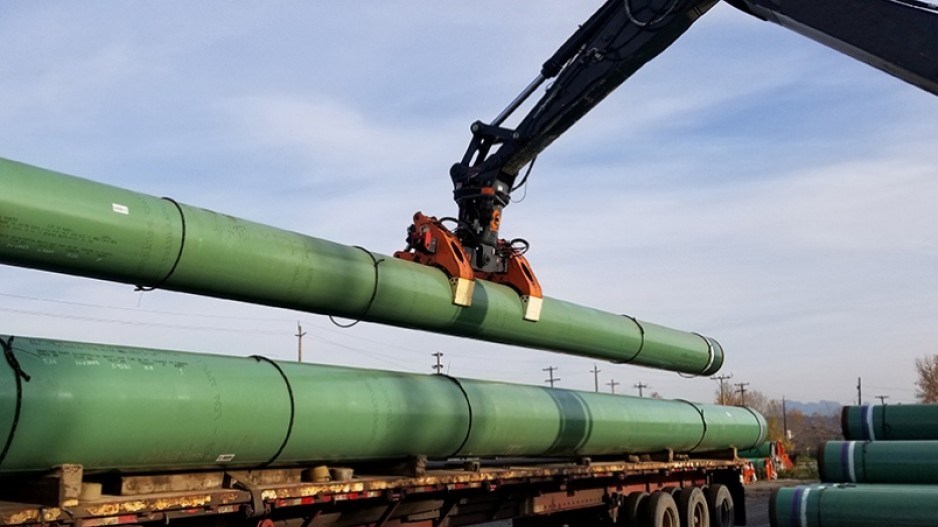If the Trudeau government wants to sell the Trans Mountain pipeline, once it has completed a $12.6 billion expansion that will nearly triple its capacity, it may have to give potential buyers assurances about the kinds of new climate change policies it plans to enact.
Otherwise, it could be stuck owning the pipeline, the profitability and value of which could erode over the coming decades, partly as a result of the government’s own policies.
That's one possible reading of a new report on the Trans Mountain pipeline expansion project by Parliamentary Budget Officer Yves Giroux.
"The government’s decision to acquire, expand, operate, and eventually divest of the Trans Mountain Pipeline System continues to be profitable,” Giroux states in a preface to his report.
“However, the profitability of the assets is highly contingent on the climate policy stance of the federal government and on the future utilization rate of the pipeline."
Increasing stringency in climate change policies is just one of the risks the project faces that could decrease its value, however. There could be others, including increased competition from other new pipelines, or a delay in completing and commissioning the project.
The Trudeau government ended up buying the Trans Mountain pipeline from Kinder Morgan (NYSE:KMI) – which decided to abandon the project in frustration -- and assumed responsibility for expanding it with a second line. It paid $4.4 billion for the existing pipeline and terminal. The total expansion project is budgeted at $12.6 billion.
The Trudeau government plans to sell the pipeline when the expansion is complete – slated for December 2022.
But any potential buyer will no doubt be carefully reading the PBO’s new analysis of the project’s economics and the risks it faces.
One of those risks is a potential decline in global demand for oil in general in the coming decades, as the world moves to decarbonize. The other risk comes from the federal government itself, in the form of future climate change policies that it might enact.
“One significant finding of this study is that the government’s 2018 decision to acquire, expand, operate, and eventually divest of the Trans Mountain assets continues to have been profitable for the federal government, given the current climate policy framework,” the PBO report states.
“However, another significant finding is that the profitability of the Trans Mountain assets is highly contingent on the climate policy stance of the federal government. Consistent with modelling from the Canada Energy Regulator (CER), if policy action on climate change continues to become more stringent, it is possible for the Trans Mountain assets to have a negative net present value.”
After the $4.4 billion the federal government spent to acquire the existing Trans Mountain pipeline is subtracted from the $5 billion in estimated present cash flow value, the PBO estimates the pipeline to have a net present value of $600 million.
That could go into the negative, however, depending on a number of risks, including if there is a delay in completing the twinning project. Also, a 5% decrease in pipeline utilization would result in a negative value of minus $400 million.
The PBO estimated the pipeline’s impact on Canada’s GDP, and found, not surprisingly, that the biggest impact is during the pipeline’s construction. During the construction phase, it estimates that $140 in real GDP will be generated for every $100 spent on construction.
That translates into a 0.18% increase in Canadian annual real GDP during construction, and 0.06% in 2025.
“The impact on employment would follow a similar pattern with a peak annual employment impact of 17,050 jobs added in 2021 and decline steadily thereafter.”
The report also estimates the value of the new pipeline to Alberta producers in terms of increasing oil prices.
The optionality that the new pipeline would provide would reduce the price difference between the benchmark West Texas Intermediate (WTI) and Western Canadian Select (WCS).
The discount on WCS compared to WTI varies, but has averaged out to about $20 per barrel. Lack of pipeline capacity is partly responsible for that discount.
The PBO estimates the newly twinned Trans Mountain pipeline would shave $5 per barrel off the differential. That $5 difference would increase Canada’s nominal GDP by $6 billion annually, the PBO estimates.
Once the pipeline is expanded and commissioned, it is “almost assured to garner regulated tolls” for 80% of its capacity for 20 years, the PBO report states.
That’s because the 13 shippers who signed up for contracts on the pipeline are locked in to paying tolls for periods of about 20 years. The remaining 20% of capacity is open to the spot market.
After those contracts expire, it becomes less certain how much money the pipeline will generate. That depends to a large extent on how many shippers continue to sign up for long-term commitments past 2040.
“However, in light of certain scenarios for oil supply in recent energy market projections, there is a risk that shippers will choose to not re-enter into committed contracts in the 2040s,” the PBO report says.
It also depends on how much other pipeline capacity is available. Should the Keystone XL pipeline be built, for example, there may be pipeline capacity that is surplus to Alberta’s oil production.
However, as some observers point out, Trans Mountain has one competitive advantage over other new pipelines: It’s the only one that offers access to the West Coast and other markets – notably California and Asia.




